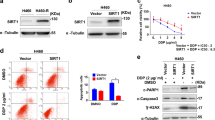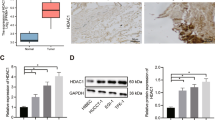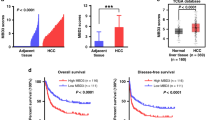Abstract
The MST/YAP (mammalian Ste20-like kinase/Yes-associated protein 2) pathway plays an important role in hepatocellular carcinoma (HCC). Although post-translational modification—especially MST/Lats (large tumor suppressor)-mediated phosphorylation and PP1 (protein phosphatase-1)-mediated dephosphorylation—has been found to regulate the activity of YAP2, very little is known about its acetylation. In our experiments, we observed that the expression of SIRT1 is significantly upregulated in the tumor samples of the hepatocarcinoma patients, and SIRT1 mRNA level positively correlates with connective tissue growth factor (CTGF) mRNA level. We then found that SIRT1 deacetylates YAP2 protein in HCC cells and SIRT1-mediated deacetylation increases the YAP2/TEAD4 association, leading to YAP2/TEAD4 transcriptional activation and upregulated cell growth in HCC cells. Moreover, knockdown of SIRT1 blocks the cisplatin (CDDP)-induced nuclear translocation of YAP2 and enhances the chemosensitivity of HCC cells to CDDP treatment. Together, our findings reveal a new regulatory mechanism of YAP2 by the SIRT1-mediated deacetylation that may be involved in HCC tumorigenesis and drug resistance.
This is a preview of subscription content, access via your institution
Access options
Subscribe to this journal
Receive 50 print issues and online access
$259.00 per year
only $5.18 per issue
Buy this article
- Purchase on Springer Link
- Instant access to full article PDF
Prices may be subject to local taxes which are calculated during checkout




Similar content being viewed by others
Abbreviations
- HCC:
-
hepatocellular carcinoma
- NAD:
-
nicotinamide adenine dinucleotide
- YAP2:
-
Yes-associated protein 2.
References
Parkin DM, Bray F, Ferlay J, Pisani P . Estimating the world cancer burden: Globocan 2000. Int J Cancer 2001; 94: 153–156.
Parkin DM, Bray F, Ferlay J, Pisani P . Global cancer statistics, 2002. CA Cancer J Clin 2005; 55: 74–108.
El-Serag HB, Rudolph KL . Hepatocellular carcinoma: epidemiology and molecular carcinogenesis. Gastroenterology 2007; 132: 2557–2576.
Huang J, Wu S, Barrera J, Matthews K, Pan D . The Hippo signaling pathway coordinately regulates cell proliferation and apoptosis by inactivating Yorkie, the Drosophila Homolog of YAP. Cell 2005; 122: 421–434.
Vassilev A, Kaneko KJ, Shu H, Zhao Y, DePamphilis ML . TEAD/TEF transcription factors utilize the activation domain of YAP65, a Src/Yes-associated protein localized in the cytoplasm. Genes Dev 2001; 15: 1229–1241.
Chan SW, Lim CJ, Loo LS, Chong YF, Huang C, Hong W . TEADs mediate nuclear retention of TAZ to promote oncogenic transformation. J Biol Chem 2009; 284: 14347–14358.
Zhang H, Liu CY, Zha ZY, Zhao B, Yao J, Zhao S et al. TEAD transcription factors mediate the function of TAZ in cell growth and epithelial-mesenchymal transition. J Biol Chem 2009; 284: 13355–13362.
Camargo FD, Gokhale S, Johnnidis JB, Fu D, Bell GW, Jaenisch R et al. YAP1 increases organ size and expands undifferentiated progenitor cells. Curr Biol 2007; 17: 2054–2060.
Dong J, Feldmann G, Huang J, Wu S, Zhang N, Comerford SA et al. Elucidation of a universal size-control mechanism in Drosophila and mammals. Cell 2007; 130: 1120–1133.
Zhou D, Conrad C, Xia F, Park JS, Payer B, Yin Y et al. Mst1 and Mst2 maintain hepatocyte quiescence and suppress hepatocellular carcinoma development through inactivation of the Yap1 oncogene. Cancer Cell 2009; 16: 425–438.
Urtasun R, Latasa MU, Demartis MI, Balzani S, Goni S, Garcia-Irigoyen O et al. Connective tissue growth factor autocriny in human hepatocellular carcinoma: oncogenic role and regulation by epidermal growth factor receptor/yes-associated protein-mediated activation. Hepatology 2011; 54: 2149–2158.
Vaziri H, Dessain SK, Ng Eaton E, Imai SI, Frye RA, Pandita TK et al. hSIR2(SIRT1) functions as an NAD-dependent p53 deacetylase. Cell 2001; 107: 149–159.
Wang C, Chen L, Hou X, Li Z, Kabra N, Ma Y et al. Interactions between E2F1 and SirT1 regulate apoptotic response to DNA damage. Nat Cell Biol 2006; 8: 1025–1031.
Brunet A, Sweeney LB, Sturgill JF, Chua KF, Greer PL, Lin Y et al. Stress-dependent regulation of FOXO transcription factors by the SIRT1 deacetylase. Science 2004; 303: 2011–2015.
Yeung F, Hoberg JE, Ramsey CS, Keller MD, Jones DR, Frye RA et al. Modulation of NF-kappaB-dependent transcription and cell survival by the SIRT1 deacetylase. EMBO J 2004; 23: 2369–2380.
Mao B, Zhao G, Lv X, Chen HZ, Xue Z, Yang B et al. Sirt1 deacetylates c-Myc and promotes c-Myc/Max association. Int J Biochem Cell Biol 2011; 43: 1573–1581.
Zhao B, Wei X, Li W, Udan RS, Yang Q, Kim J et al. Inactivation of YAP oncoprotein by the Hippo pathway is involved in cell contact inhibition and tissue growth control. Genes Dev 2007; 21: 2747–2761.
Lan F, Cacicedo JM, Ruderman N, Ido Y . SIRT1 modulation of the acetylation status, cytosolic localization, and activity of LKB1. Possible role in AMP-activated protein kinase activation. J Biol Chem 2008; 283: 27628–27635.
Cohen HY, Lavu S, Bitterman KJ, Hekking B, Imahiyerobo TA, Miller C et al. Acetylation of the C terminus of Ku70 by CBP and PCAF controls Bax-mediated apoptosis. Mol Cell 2004; 13: 627–638.
Matsuzaki H, Daitoku H, Hatta M, Aoyama H, Yoshimochi K, Fukamizu A . Acetylation of Foxo1 alters its DNA-binding ability and sensitivity to phosphorylation. Proc Natl Acad Sci USA 2005; 102: 11278–11283.
Du Z, Song J, Wang Y, Zhao Y, Guda K, Yang S et al. DNMT1 stability is regulated by proteins coordinating deubiquitination and acetylation-driven ubiquitination. Sci Signal 2010; 3: ra80.
Hata S, Hirayama J, Kajiho H, Nakagawa K, Hata Y, Katada T et al. A novel acetylation cycle of transcription co-activator Yes-associated protein that is downstream of Hippo pathway is triggered in response to SN2 alkylating agents. J Biol Chem 287: 22089–22098.
Wang P, Bai Y, Song B, Wang Y, Liu D, Lai Y et al. PP1A-mediated dephosphorylation positively regulates YAP2 activity. PLoS One 2011; 6: e24288.
Hao Y, Chun A, Cheung K, Rashidi B, Yang X . Tumor suppressor LATS1 is a negative regulator of oncogene YAP. J Biol Chem 2008; 283: 5496–5509.
Dai JM, Wang ZY, Sun DC, Lin RX, Wang SQ . SIRT1 interacts with p73 and suppresses p73-dependent transcriptional activity. J Cell Physiol 2007; 210: 161–166.
Costanzo A, Merlo P, Pediconi N, Fulco M, Sartorelli V, Cole PA et al. DNA damage-dependent acetylation of p73 dictates the selective activation of apoptotic target genes. Mol Cell 2002; 9: 175–186.
Brooks CL, Gu W . The impact of acetylation and deacetylation on the p53 pathway. Protein Cell 2011; 2: 456–462.
Martinez-Balbas MA, Bauer UM, Nielsen SJ, Brehm A, Kouzarides T . Regulation of E2F1 activity by acetylation. EMBO J 2000; 19: 662–671.
Molloy D, Mapp KL, Webster R, Gallimore PH, Grand RJ . Acetylation at a lysine residue adjacent to the CtBP binding motif within adenovirus 12 E1A causes structural disruption and limited reduction of CtBP binding. Virology 2006; 355: 115–126.
Zhao B, Ye X, Yu J, Li L, Li W, Li S et al. TEAD mediates YAP-dependent gene induction and growth control. Genes Dev 2008; 22: 1962–1971.
Kemper JK, Xiao Z, Ponugoti B, Miao J, Fang S, Kanamaluru D et al. FXR acetylation is normally dynamically regulated by p300 and SIRT1 but constitutively elevated in metabolic disease states. Cell Metab 2009; 10: 392–404.
Firestein R, Blander G, Michan S, Oberdoerffer P, Ogino S, Campbell J et al. The SIRT1 deacetylase suppresses intestinal tumorigenesis and colon cancer growth. PLoS One 2008; 3: e2020.
Acknowledgements
We thank Dr Depei Liu for the gift of all the SIRT1 plasmids; Dr Lei Zhang for the 3*SD binding site artificial-luciferase reporter plasmid; Dr Zhixiong Xiao for the p73 antibody; Ursula Adams for manuscript editing; and Xudong Zhao and Su Liu of IBP core facility center for technical support. This work was supported by the National Science Foundation of China (81172553, 81201564, 81125010 and 81030025), and the Ministry of Science and Technology of China (973-2009CB918704 and 973-2012CB910701).
Author information
Authors and Affiliations
Corresponding authors
Ethics declarations
Competing interests
The authors declare no conflict of interest.
Additional information
Supplementary Information accompanies this paper on the Oncogene website
Supplementary information
Rights and permissions
About this article
Cite this article
Mao, B., Hu, F., Cheng, J. et al. SIRT1 regulates YAP2-mediated cell proliferation and chemoresistance in hepatocellular carcinoma. Oncogene 33, 1468–1474 (2014). https://doi.org/10.1038/onc.2013.88
Received:
Revised:
Accepted:
Published:
Issue Date:
DOI: https://doi.org/10.1038/onc.2013.88
Keywords
This article is cited by
-
Activating the Hippo pathway by nevadensin overcomes Yap-drived resistance to sorafenib in hepatocellular carcinoma
Discover Oncology (2023)
-
Complex roles of Hippo-YAP/TAZ signaling in hepatocellular carcinoma
Journal of Cancer Research and Clinical Oncology (2023)
-
Sirtuin 5-mediated deacetylation of TAZ at K54 promotes melanoma development
Cellular Oncology (2023)
-
Sirt1 deacetylates and stabilizes p62 to promote hepato-carcinogenesis
Cell Death & Disease (2021)
-
Sirt1 deficiency upregulates glutathione metabolism to prevent hepatocellular carcinoma initiation in mice
Oncogene (2021)



